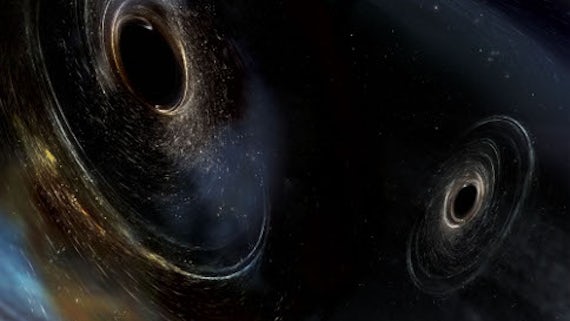Third gravitational wave detection uncovers clues to how black holes are born
1 Mehefin 2017

Advanced algorithms jointly developed by the Gravitational Physics research group in the School of Physics and Astronomy have enabled the Laser Interferometer Gravitational-wave Observatory (LIGO) team to observe a giant pair of spinning black holes over three billion light years away.
With the announcement of these results today, Thursday 1st June, this is the third time that the LIGO team have detected gravitational waves, and suggests intriguing properties of their origin.
The detection was made on 4th January 2017 and has been called GW170104. It is the first announcement to come from the experiment’s second observing run, which began in late 2016 and is expected to run until later this year.
Gravitational waves are tiny ripples in space and time that are emitted from violent cosmic events, such as exploding stars and merging black holes. Gravitational waves carry information about their dramatic origins and about the nature of gravity that cannot otherwise be obtained.
Up until now, gravitational waves have only ever been detected twice, the first of which was achieved by the LIGO team in September 2015 and the second in December 2015, using twin detectors in the US.
The latest observation confirms the existence of a pair of giant black holes with masses about 20 and 30 times the mass of our Sun. Once merged, the resulting black hole had a mass of around 49 times that of our Sun, losing the energy equivalent of 2 solar mass to gravitational waves. The discovery of another pair of massive black holes implies that such objects may not be as rare as some predicted, and gives further assurance that the first detection back in 2015 wasn’t a fluke.
The recent detection is also the farthest yet, with the black holes lying about 3 billion light-years away from Earth (previous detections were 1.3 and 1.4 billion light-years away).
The results also suggest that the two black holes may be ‘non-aligned’, meaning that they are spinning in opposite directions as they orbit each other.
This could suggest that rather than being born together and spinning in the same direction, the two black holes may have come together later in life in a crowded stellar environment. In this theory a pair of black holes can be aligned, anti-aligned or mis-aligned.
"This is the first time that we have evidence that the black holes may not be aligned, which amounts to just a tiny hint that binary black holes may form in dense stellar clusters. More observations are needed to understand which, among a number of different binary black hole formation models, might be the predominant contributor to mergers observed by LIGO," says Cardiff University and Penn State University’s Professor Bangalore Sathyaprakash, one of the editors for the study.
For the past decade, the Gravitational Physics Group at Cardiff University have laid the foundations for how we go about detecting gravitational waves and have developed novel algorithms and software that have now become standard search tools for detecting the elusive signals.
The Group also includes world-leading experts in the collision of black holes, who have produced large-scale computer simulations to imitate these violent cosmic events and predict how gravitational waves are emitted as a consequence. These calculations were instrumental in decoding the observed gravitational-wave signal to measure the properties of the two black holes.
Professor Mark Hannam, from Cardiff University’s Gravitational Physics Group, said: “Here at Cardiff we've been calculating the predictions of general relativity more accurately than ever before to see if Nature agrees – and it does.”
“We are looking forward to applying new techniques, such as machine learning, to further improve our gravitational wave searches and enable us to see more gravitational waves,” says Professor Stephen Fairhurst, Director of the Data Innovation Research Institute at Cardiff University. “We are also using these same methods to address other big data problems in science and medicine.”